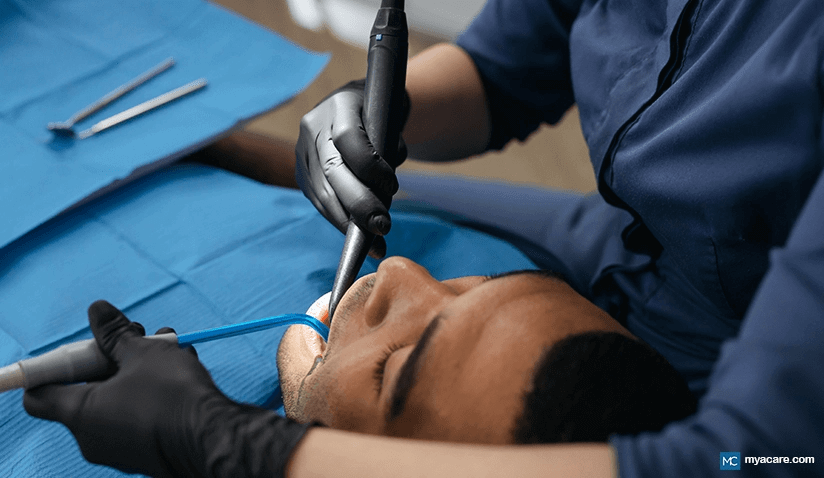How to Manage Bruxism or Grinding of Teeth?

Bruxism is an involuntary habit of clenching and grinding teeth. It impacts the biting surfaces of upper and lower teeth. A continuous force over a period of time may damage the teeth through tooth wear, fracture of restorations, and headaches. If unchecked, it may cause facial pain and temporomandibular joint disorders.
Globally, bruxism is prevalent among 8-31% of the general population and 14-20% of children. It is less common in the older age groups, especially among 60 years and above.
In this article, we help you understand the causes of bruxism and how to manage it.
What are the Different Types of Bruxism?
Bruxism may occur while an individual is awake or asleep. Bruxism occurring while awake is known as diurnal bruxism and during sleep is known as nocturnal bruxism. Diurnal type is more common in females than males and is associated with stress and anxiety. On the other hand, nocturnal bruxism is equally prevalent in both genders and is more common in children. It is associated with sleep disorders such as snoring and sleep apnea (temporarily stopping breathing during sleep).
What are the Causes of Bruxism?
The exact cause of bruxism is unknown. However, there are multiple factors involved which may cause bruxism. These include:
- Psychosocial factors: The presence of a stressful lifestyle or inability to express anxiety, hate, or aggression can contribute to bruxism. Among two types of bruxism, the diurnal type is associated with work pressure or stress due to familial responsibilities. Individuals with aggressive, competitive, and hyperactive personality traits are at higher risk of teeth grinding.
- Genetic factors: Research suggests that about 21-50% of people with nocturnal bruxism have a direct family member who had a similar condition during their childhood. This suggests the involvement of genetic factors.
- Medications: Intake of several medications with long-term use may trigger bruxism in individuals. These medications include:
- Antidepressants (e.g., Tricyclic antidepressants, Selective serotonin reuptake inhibitors)
- Antipsychotics (e.g., Dopamine)
- Antiparkinson (e.g., Dopamine agonists)
- Interferences while biting: Any kind of interference in the normal path of biting is associated with bruxism. The presence of factors such as premature contact between teeth (some teeth occlude early and others later), overfilled restorations, or different shape or positioning of teeth may interfere with the bite and deflect it from the normal biting pathway. This can lead to abnormal jaw movements or grinding of teeth.
- Habits: Excess smoking, intake of alcohol and caffeine are associated with the increased chances of bruxism.
- Other conditions: The presence of conditions such as epilepsy, sleep-related disorders, dementia, Parkinson’s disease, torus mandibularis (bony overgrowth in lower jaw), down syndrome, trauma, and atypical facial pain is associated with involuntary grinding of teeth.
What are the Commonly Observed Symptoms of Bruxism?
Here are some of the symptoms that are observed during bruxism:
- Pain in the temporomandibular joint which restricts mouth opening
- Soreness in the muscles of the face or neck which assist in chewing
- Headache especially in the morning when an individual wakes up
- The characteristic annoying sound created with grinding of teeth
- Flattened surfaces of teeth
- Hypersensitive teeth
- Loosening of teeth
- Fatigue (due to poor sleep quality)
- Receding of gums
- Fracture of teeth
- Fracture of fillings or dislodgement of crowns
How is Bruxism Diagnosed?
Bruxism can be diagnosed clinically with self-reporting of symptoms by an individual followed by clinical examination by the dentist. The presence of features such as tooth wear, sounds of grinding of teeth during sleep, loosening of teeth, soreness in the facial muscles, limited mouth opening, frequent headaches, or frequent fracture of teeth and restorations aids in diagnosing bruxism.
Other instrumental techniques such as electromyography and polysomnography help identify bruxism by measuring muscle activity during sleep bruxism. Another technique such as the ecologic momentary assessment approach helps to assess the frequency of awake bruxism behaviors based on the report of five oral conditions. These conditions include relaxed jaw muscles, teeth contact, mandible bracing, teeth clenching, and teeth grinding.
Oral X rays also help in the assessment of damage to the teeth and the level of underlying tooth-supporting bone.
How to Manage Bruxism?
Many individuals don’t grind or clench their teeth to the extent that may require therapy. Most of the younger individuals do not take up treatment. Awake bruxism can be managed voluntarily by leaving the teeth separated. Meanwhile, nocturnal bruxism can be reduced by sleeping flat on the back without a pillow with positive thoughts.
However, if the problem persists and becomes serious, then several treatment options are available to resolve the condition. These include:
- Behavioral modifications: If the grinding of teeth is because of stress then the inclusion of relaxation techniques, meditation, yoga, hypnosis, and sleep hygiene measures can aid in the reduction of stress-induced bruxism. Individuals with anxiety or sleep disorders should meet a counselor or therapist for advice. In addition, individuals should stop smoking and drinking coffee or alcohol at night. Ensure to maintain quiet and dark bedroom conditions to experience quality sleep.
- Biofeedback: This technique uses monitoring procedures and equipment which can train them to control unwanted jaw movements through visual and verbal feedback. It is beneficial in individuals who are unable to change their habits.
- Medications: Certain medications such as muscle relaxants may be recommended by a doctor to overcome the pain and soreness of facial and temporomandibular joint muscles. Intake of anti-anxiety or anti-depressants helps overcome stress that causes bruxism. In some individuals with severe bruxism, injection of Botox (botulinum toxin) reduces the condition. Botox inhibits the release of the chemicals (acetylcholine) responsible for abnormal jaw movements.
- Bite guards: Bite guards also known as dental or mouth guards are devices that are worn over the surfaces of teeth. They cover the upper and front-back surfaces of teeth and prevent tooth damage due to bruxism along with the reduction in muscle tone. They are recommended to be worn during night time for a long term.
- Bite adjustments: Bite adjustments can be made with orthodontic treatments, selective shaping of teeth, or restoration with full mouth crowns. Adjustment of bite aids in the reduction in the interferences while biting, reducing chances of bruxism.
- Dental treatment: Individuals with teeth sensitivity or inability to chew food due to worn-off teeth should undergo restoration of damaged teeth.
To search for the best dentists in Germany, India, Malaysia, Poland, Singapore, Spain, Thailand, Turkey, the UAE, the UK and the USA, please use the Mya Care search engine.
To search for the best healthcare providers worldwide, please use the Mya Care search engine.

Dr. Shilpy Bhandari is an experienced dental surgeon, with specialization in periodontics and implantology. She received her graduate and postgraduate education from Rajiv Gandhi University of Health Sciences in India. Besides her private practice, she enjoys writing on medical topics. She is also interested in evidence-based academic writing and has published several articles in international journals.
References:
Featured Blogs



